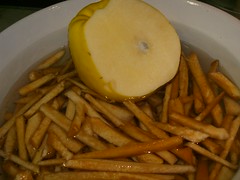
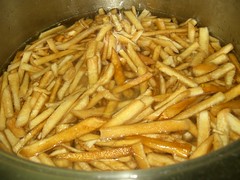


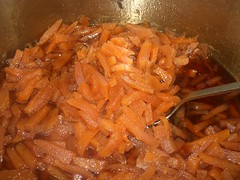

The different colour phases that quince passes through from its raw state to when it becomes a bottled spoon sweet preserve.
Quince starts off as a very ugly fruit, with its furry covering and pinched puckered pear-green skin.
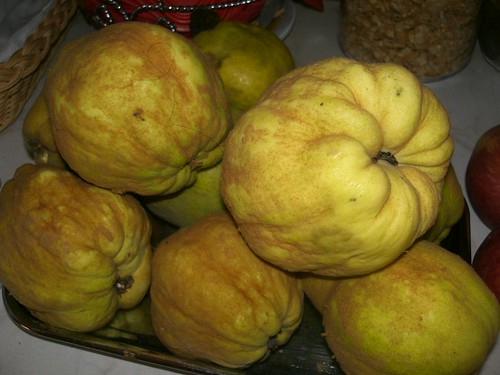
I came by this quince during one of my recent forages (all I had to do was put my hand out the car window).
As you slice through it with a carving knife (at first, it seems hard and astringent), you come across a lily white interior which lasts for just a few seconds before it starts to oxidise. Never mind its rusty rotten looks; its aroma is intoxicating. You now have two choices: turn on the extractor fan (to mesmerise your neighbours) or secure all the doors and windows (to bathe in the aroma all by yourself).
As the chopped (or grated) quince starts to warm up in a pot of water, it begins to whiten again, as if bleach had been added to it. Leave it to simmer for an hour with analogous amount of sugar, and when you return, it will have started to turn pink, reminding you of roses, as the air will now be highly scented; if you have a few sprigs of perlagonium at hand and a freshly picked lemon, those too now. The perfume of this combination of scented plants has now permeated the air; it's time to invite your girlfriends over for a sauna in its scented warmth while the quince cooks away in the syrup.
When it's time to check it again, you'll find that it has transformed into a ruby red sea, gleaming in the heat of the heavenly aromatic syrup. The more it cooks, the redder it becomes.
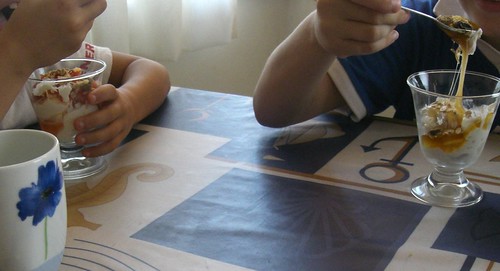
My favorite way to enjoy this dessert is with Greek strained yoghurt and muesli (or nut) topping. The quince dessert can also be replaced with honey if you don't have access to this spoon sweet (it is probably available from Greek specialty shops in most parts fo the world).
©All Rights Reserved/Organically cooked. No part of this blog may be reproduced and/or copied by any means without prior consent from Maria Verivaki.

I came by this quince during one of my recent forages (all I had to do was put my hand out the car window).
As you slice through it with a carving knife (at first, it seems hard and astringent), you come across a lily white interior which lasts for just a few seconds before it starts to oxidise. Never mind its rusty rotten looks; its aroma is intoxicating. You now have two choices: turn on the extractor fan (to mesmerise your neighbours) or secure all the doors and windows (to bathe in the aroma all by yourself).
As the chopped (or grated) quince starts to warm up in a pot of water, it begins to whiten again, as if bleach had been added to it. Leave it to simmer for an hour with analogous amount of sugar, and when you return, it will have started to turn pink, reminding you of roses, as the air will now be highly scented; if you have a few sprigs of perlagonium at hand and a freshly picked lemon, those too now. The perfume of this combination of scented plants has now permeated the air; it's time to invite your girlfriends over for a sauna in its scented warmth while the quince cooks away in the syrup.
When it's time to check it again, you'll find that it has transformed into a ruby red sea, gleaming in the heat of the heavenly aromatic syrup. The more it cooks, the redder it becomes.

My favorite way to enjoy this dessert is with Greek strained yoghurt and muesli (or nut) topping. The quince dessert can also be replaced with honey if you don't have access to this spoon sweet (it is probably available from Greek specialty shops in most parts fo the world).
And there you have it: quince spoon sweet, signaling the coming of Christmas and a taste of autumn rain, redolent of the approaching winter as autumn yields to it; there is nothing, absolutely nothing quite like it.
©All Rights Reserved/Organically cooked. No part of this blog may be reproduced and/or copied by any means without prior consent from Maria Verivaki.
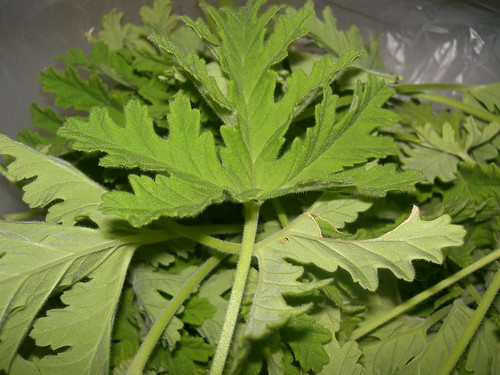
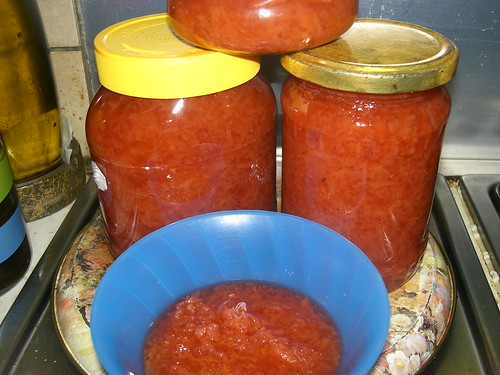
Lovely...I know how beautiful it smells.
ReplyDeleteI have finally grown to really enjoy quince, it took me 2 yrs and my own trees but I do really, really enjoy it.
Have a wonderful week!!
Oh Maria, I can smell the beautiful quince scent now in my mind. I love making quince jelly which I adore with a good blue cheese. I know I have at least one large jar of it at the back of a cupboard so Quince Jelly and Yoghurt here I come!
ReplyDeleteWow, that looks like a great way to eat quince! Is there a particular type of pelargonium you use?
ReplyDeleteVery interesting! I've had a lemon pelargonium for many years, but had no idea the leaves can be eaten.
ReplyDeleteI googled "quince" and "kydonia" (I think I only knew the word from a Xylouris song?), found a movie about a spanish arstist painting a Quince tree "El Sol del Membrillo".
I'll try to buy some fruits. They're called "kweepeer" here in Holland.
perlagonium is a sweetly scented kind of geranium: it produces pinky purple flowers
ReplyDeleteboth quince and perlagonium produce intoxicating aromas - they remind me of a unique rose
i've also heard that quince and blue cheese go really well together, as do pear jelly (unripe pear resembles quince) with cheese - nice scented combinations
I haven't done enough with quince and look forward to finding some in the fruit and vegetable markets in the upcoming weeks. The quince over yogurt is a delightful dessert.
ReplyDeleteI am really enjoying our quince preserve I made a few weeks ago. Next time I will boil it longer to see if it goes redder. It is very aromatic that's for sure.
ReplyDeleteI have that very perlagonium (pelagonium to me) growing out from my front door. In the northern places of NZ it is grown to deter wasps and other flying beasties as the oils and aromatics within the plant become very concentrated in hot, dry climates - without needing to remove the oils from the living plants. I just love the fragrance from the leaves when ever I brush by it.
ReplyDeleteNow, come next quince jelly season (April next year) ...... Mickle will be experimenting.
Wow, looking forward to it, dear Maria.
Sending many caring huggles, Michelle and a snoring away Zebbycat, xxx and ........ snore still
Yes yes yes! THE BEST WAY TO ENJOY THIS IS WITH GREEK YOGURT!!! I love quince in every way and I am sure those "stolen" quince were yummy...
ReplyDeleteMy mom swears by making quince glyko with "barbaroza" or as we call it here, citronella. It's the same plant that detracts mosquitos. Who'd thunk to also use it to perfume a spoon sweet!
ReplyDeleteperlagonium - barbarossa; thanks for reminding me of that word, i had almost forgotten it!
ReplyDeleteΣυνταγές για μαγείρεμα με κυδώνια και κρέας;
ReplyDeleteκυδώνια με χοιρινο, πολυ δημοφιλης και στην Κρητη - κοψε τα κυδώνια οπως και τις πατατες και ψησε τα ολα στο φουρνο
Delete